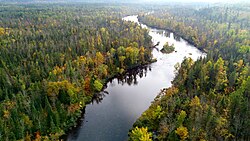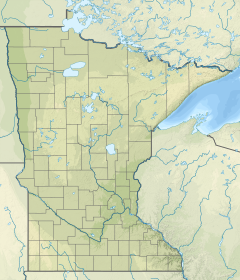St. Croix River (Wisconsin–Minnesota)
The St. Croix River (English: Holy Cross) is a tributary of the Mississippi River. It is about 169 miles (272 km) long.[3] The St. Croix flows in the U.S. states of Wisconsin and Minnesota. The lower 125 miles (201 km) of the river forms the border between Wisconsin and Minnesota. The river is a National Scenic Riverway under the protection of the National Park Service. A hydroelectric plant at St. Croix Falls supplies electricity to the Minneapolis–St. Paul metropolitan area.
| St. Croix River | |
|---|---|
 The St. Croix River | |
 Map of the St. Croix watershed. | |
| Location | |
| Country | United States |
| State | Wisconsin, Minnesota |
| Cities | St. Croix Falls, WI, Taylors Falls, MN, Osceola, WI, Stillwater, MN, Hudson, WI, Prescott, WI, Somerset, WI, River Falls, WI |
| Physical characteristics | |
| Source | Upper St. Croix Lake |
| - location | near Solon Springs, Wisconsin, Douglas County, WI |
| - coordinates | 46°23′19″N 91°45′34″W / 46.38861°N 91.75944°W |
| Mouth | Mississippi River |
| - location | Prescott, WI, Pierce County, Washington, Dakota, MN, WI |
| - coordinates | 44°44′45″N 92°48′10″W / 44.74583°N 92.80278°W |
| Length | 169 mi (272 km) |
| Basin size | 7,700 sq mi (20,000 km2)[2] |
| Discharge | |
| - location | Prescott, WI |
| - average | 6,374 cu/ft. per sec.[1] |
| Basin features | |
| Tributaries | |
| - left | Sunrise River, Snake River, Kettle River, Trout Brook |
| - right | Apple River, Yellow River, Namekagon River, Eau Claire River (St. Croix River), Kinnickinnic River |
| Type | Scenic, Recreational |
| Designated | October 2, 1968 |
| Part of | Saint Croix National Scenic Riverway |
Naming
changeFather Louis Hennepin wrote in 1683, from information probably provided by Daniel Greysolon, Sieur du Lhut: "There is another River which falls ... into the Meschasipi ... We named it The River of the Grave, or Mausoleum, because the Savages buried there one of their Men ... who was bitten by a Rattlesnake." Father Hennepin called it in French Rivière du Tombeaux.[4]
There are several possible explanations for the origin of the present name. An early map dated to 1688 recorded a "Fort St. Croix" on the upper part of the river.[5] Near the mouth of the river was a French Voyageur's grave marked with a cross. The most likely explanation was that it was named for a French trader named Sainte-Croix.[5] The name "Rivière de Sainte-Croix" was applied to the river sometime in 1688 or 1689.[4]
On Map of the Territories of Michigan and Ouisconsin (1830) by John Farmer, the St. Croix River is shown as the "Chippewa River". However, by 1843, Joseph Nicollet's Hydrographical Basin of the Upper Mississippi River reinforced the name provided by Franquelin's 1688 map.
History
changeThe river valley and the surrounding area was originally occupied by the Ojibwe, Dakota and nine other American Indian tribes. The Indians mainly lived on wild rice, fish, and game. By the eighteenth century, the Ojibwe and Dakota were the two main tribes that inhabited the area. This lasted until around 1745, when the Dakota were driven from the St. Croix Valley as a result of the Battle of Kathio.[4] It is worth noting that many Dakota and Ojibwe people still occupy this area to this day, as it is particularly considered a part of Dakota homeland.
Fur trade
changeThe first Europeans to arrive in the area were Sieur du Lhut and his men in the fall and winter of 1679-1680. For the next eighty years the area was mainly under French influence. The fur trade grew throughout the first half of the eighteenth century. Beaver pelts were one of the main products. French trade in the upper valley was dominated by the Ojibwe. They were tied to Lake Superior traders. In the lower valley the Dakota assisted in trading with merchants based out of St. Louis.[6] After the end of the French and Indian War in 1763, British traders entered the area. They grew in numbers and influence with the help of the powerful North West Company.[7]
Logging
changeThe 1837 Treaty of St. Peters with the Ojibwe gave the United States government a large tract of land in what today is north central Wisconsin and east central Minnesota. This opened the region to logging. The river was important to float the logs downstream to the sawmills that processed it. During the 1840s, important sawmills were located at St. Croix Falls and Marine on St. Croix. In the 1850s Stillwater became the primary lumber destination. During this time the population of Stillwater grew rapidly. New sawmills were opened, and the town saw an influx of capital, primarily from lumber companies based in St. Louis. In 1856 construction began on a boom site two miles north of Stillwater. It was used to hold and sort the logs floating downstream. The boom was in operation for over fifty years.[8] The St. Croix Boom Site is now a wayside rest and National Historic Landmark along Minnesota State Highway 95.
There were vast white pine forests in the upper St. Croix river valley. They provided the forest products that built the towns along Lake St. Croix, Minneapolis and St. Paul. The St. Croix along with the forests in Red Cedar, Chippewa, and Rum valleys provided supplies for the building of Winona, Minnesota, Davenport, Iowa, Rock Island, Illinois, and St. Louis.[6]
The lumber industry continued to grow throughout the latter half of the nineteenth century, with larger log drives in the spring caused dangers to navigation on the river above Stillwater. Logs were frequently caught in log jams at the narrow parts of the St. Croix River near St. Croix Falls. In 1883 the blockade was so severe it took almost two months before the flow of logs was re-established.[9] At its peak in 1890, logging in the St. Croix River valley produced 450,000,000 board feet (1,100,000 m3) of lumber and logs.[6] The lumber industry continued until the last major log drive in 1912 marked the end of the rich white pine forests of the area.
It was along the banks of the St. Croix, in the milltown of Stillwater, that the state of Minnesota was first proposed in 1848.
Geography and hydrography
changeThe St. Croix River starts in the northwestern corner of Wisconsin. It flows out of Upper St. Croix Lake in Douglas County. The lake is near Solon Springs, approximately 20 miles (32 km) south of Lake Superior. The St. Croix flows south into Gordon, then southwest. It is joined by the Namekagon River in northern Burnett County. A few miles downstream the St. Croix meets the boundary between Minnesota and Wisconsin. It marks that boundary for another 130 miles (209 km) until its confluence with the Mississippi River.
Conservation efforts
changeThe St. Croix River was one of the original eight rivers to be protected by the National Wild and Scenic Rivers Act of 1968. The upper parts of the river for the first 15 miles (24 km) and the Namekagon River are protected as the "St. Croix National Scenic Riverway". The only interruption is a hydroelectric dam operated by the Northern States Power Company at St. Croix Falls, Wisconsin. The lower 27 miles (43 km), including both sides of the river along the Minnesota-Wisconsin border, were protected as part of the "Lower St. Croix National Scenic Riverway".
References
change- ↑ "St. Croix River". USGS. Retrieved May 17, 2021.
- ↑ Minnesota Forests Resources Council (2013). "St. Croix River Basin" (PDF). St. Croix River Association. Retrieved May 17, 2021.
- ↑ U.S. Geological Survey. National Hydrography Dataset high-resolution flowline data. The National Map Archived 2017-08-23 at the Wayback Machine, accessed October 5, 2012
- ↑ 4.0 4.1 4.2 James Taylor Dunn, The St. Croix: Midwest Border River (New York: Holt, Rinehart and Winston, 1965), p. 28
- ↑ 5.0 5.1 Thomas F. Waters, The Streams and Rivers of Minnesota (Minneapolis: University of Minnesota Press, 1998), 142
- ↑ 6.0 6.1 6.2 Eileen M. McMahon; Theodore J. Karamanski, North Woods River: The St. Croix River in Upper Midwest History (Madison, WI: University of Wisconsin Press, 2009), p. 73
- ↑ James Taylor Dunn, The St. Croix: Midwest Border River (New York: Holt, Rinehart and Winston, 1965), pp. 32–35
- ↑ James Taylor Dunn, The St. Croix: Midwest Border River (New York: Holt, Rinehart and Winston, 1965), p. 102
- ↑ James Taylor Dunn, The St. Croix: Midwest Border River (New York: Holt, Rinehart and Winston, 1965), p. 76

